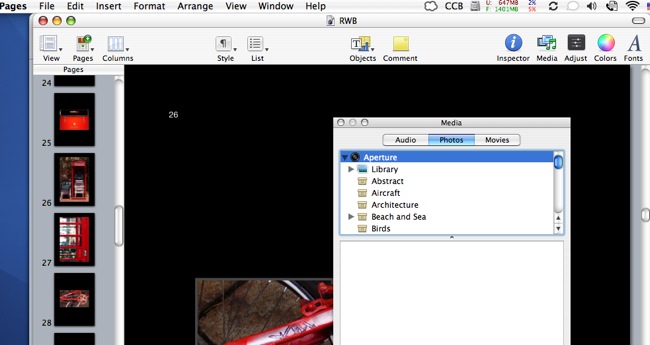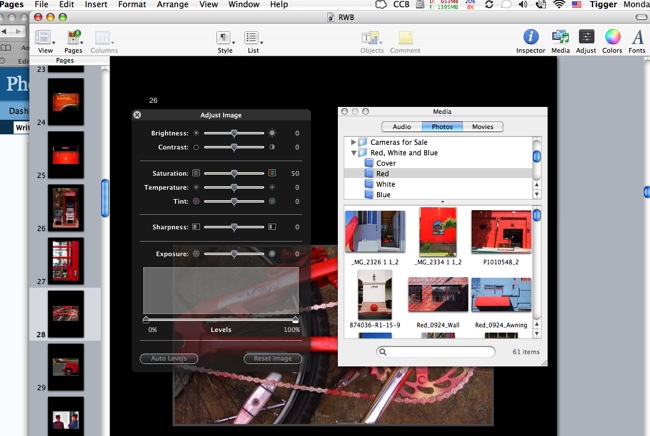Another dynamite Apple application for photographers
Now before questionable grammar in the title of this piece suggests that I am a recent graduate of the taxpayer fraud that goes by the name of the California Public School System, let me put you on the straight and narrow.
What I’m talking about is Apple’s Pages application, now in its second iteration and included as part of the software suite sold under the name iWork ’06. When Apple upgraded Aperture to Version 1.5 they conferred minor upgrades on iPhoto and Pages (and lots of other iLife applications) to permit easy interchange of files.
Pages, typifying the ‘think different’ (now that was penned by a CA school grad) philosophy at Apple, is a template driven page composition tool. That sounds pretty grand, but wait. Much more than a word processor, it dictates that you set up templates for various sections of a document or book, then insert text, graphics and pictures into the appropriate template. I don’t know, but I imagine that’s how professional typesetters and bookmakers do it. Like Aperture, the approach takes a bit of getting used to but once it clicks you wonder how you ever lived without it.
Here’s a screenshot of Pages 2.0.2 showing the integration with Aperture and iPhoto albums – part of the Aperture album is shown.

To the left you can see thumbnails of the pages in the document, which happens to be a book of photographs I am working on. Like Aperture, Pages is no Ferrari on my iMac PPC G5, but it’s OK. Meaning sometimes you have to wait a second or two before things load. So why bother with the learning curve and the modest performance?
Simple. Once you have established your template – say one for the cover, one for the title, one for chapter separators and one for the body/contents, it’s a matter of seconds to drag and drop a picture onto a template page.
Having stored the 125 or so pictures for the book in iPhoto albums (the higher quality available in Aperture is wasted on an 8″ x 10″ book) and having set up my contents template by modifying one of the many included with the application, (a process which took 10 minutes for this less than expert user), it took me but twenty minutes to drag and drop no fewer than 100 pictures into 100 new pages in the book document.
Here is the drag and drop process in practice – you can see thumbnails of the iPhoto album in the ‘Media’ panel (Apple calls it the Media Inspector – not very intuitive); additionally I have pulled up the ‘Adjust Image’ panel now available in Pages, giving me control over contrast, sharpness, tint, etc. in the Pages version of the photograph without affecting the source image in iPhoto.

Reordering the pictures is a drag and drop exercise.
Then you hit the ‘Print to PDF’ button and you have a perfect PDF file ready for distribution, formatted exactly as shown on the Pages screen.
How I ever managed to compose my first book in that horror that goes by the name Microsoft Word I shudder to recall. Pages is a superb application for photographers wanting to create brochures, books and the like. It may not be fast, but then it’s net speed that matters. Try making a 100+ page book with any other application out there in like time.
Great tips. Do you think it`s possible to do the the same with iWorks 1.0.2 and iPhoto 6.0.5?
What about the template you use, is it downloadable (lazy me)?
By the way, I really enjoy your site :-))
Best regards
Tor (from Norway)
Tor – the interoperability between Pages and iPhoto requires Pages 2.0.2 and iPhoto 6.05 (and Aperture 1.5 if you use that) – earlier versions will not work. Indeed, the Pages version is in turn an update to the one I originally purchased (v 2.0) – 2.0 requires the (free) downloadable upgrade to 2.0.2 to do what I illustrate. I suspect the currently shipped version of Pages is, indeed, 2.0.2, but that is not a free upgrade from Page 1.0.
If you want the ‘all black’ template I illustrate, when you have Pages 2.0.2 I can probably work out how to email it to you – I adapted it from one of the standard templates which comes with 2.0.
Thank you for your kind words on my site.
Thomas